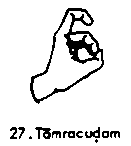07/94 Keyboard Magazine (Craig Anderton)
THE FALL FASHIONS IN MIDI APPAREL
With most controllers, your hands are subservient to an interface - strings, keyboards, drumsticks, etc. - and you make gestures designed for that interface. But what if the hand itself could be the interface? Imagine conducting an orchestra of electronics with the flick of the wrist or the bending of a finger, and you have a pretty good idea of the glove controller designed and built by French-born recording engineer/performer Laetitia Sonami (now living in Oakland, California).
The glove itself is made of golden lycra material. The only external clue to its function are the five microswitches mounted on the fingertips. But internally, there's a lot going on.
There are four variable resistances (cannibalized from the Mattel Power Glove) - one for the wrist and the remainder for three fingers. Sonami splits each resistance in middle to derive two voltages per finger. So moving the wrist or bending the fingers produces up to seven continuously variable voltages.
Additionally, each fingertip has a Hall effect transducer (a device whose output voltage varies according to the applied magnetic field), and there's a magnet mounted in the thumb. Bringing the thumb closer to a finger produces a variable voltage.
Along with the five fingertip microswitches, there's a pressure pad in the index finger; squeezing it with the thumb produces another output. Finally, there's an ultrasonic transmitter in the glove that works in conjunction with a belt-mounted receiver to track the distance between hand anad body. Sonami's inspiration for this was sign language, where the distance of the hand from the body affects the meaning of a word or phrase.
The various control signals feed into the SensorLab, which converts them into MIDI messages. Although Sonami uses the Spider programming language for some basic functions, most of the processing is done by Opcode's Max program, which translates the raw MIDI data into something her synths and samplers can use. For example, bending the wrist could produce pitch bend with one Max template, yet play different notes with another.
Why bother with yet another alternate controller (especially one that took three months of intensive labor to construct)? As Sonami says, "Using the glove lets you bypass the brain. It's like writing - when you write, you don't think about it, you just do it. And the hand is capable of very delicate gestures; it feels like you're sculpting sound". In performance, the effect of the hand motion is fluid and even sensual, but there's also a very obvious correlation between what her hand does and the sounds that emanate from the electronics. (To hear the glove controller in action, check out the CD compilations Imaginary Landscapes (Nonesuch), Another Coast (Music & Arts), and the Jewel Box (Tellus 26, NYC), which feature Sonami's work along with that of several composers.)
